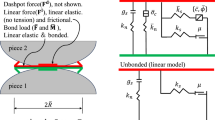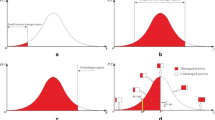Abstract
Discontinuities constitute an integral part of rock mass and inherently affect its anisotropic deformation behavior. This work focuses on the equivalent elastic deformation of rock mass with multiple persistent joint sets. A new method based on the space geometric and mechanical properties of the modified crack tensor is proposed, providing an analytical solution for the equivalent elastic compliance tensor of rock mass. A series of experiments validate the capability of the compliance tensor to accurately represent the deformation of rock mass with multiple persistent joint sets, based on conditions set by the basic hypothesis. The spatially varying rules of the equivalent elastic parameters of rock mass with a single joint set are analyzed to reveal the universal law of the stratified rock mass.
Similar content being viewed by others
References
BRADY B H. Rock mechanics for underground mining [M]. New York: Springer, 2004.
PRIEST S D. Discontinuity analysis for rock engineering [M]. New York: Springer, 1993.
MÜLLER L. Address to the opening session[C]//Proc 1st Congr, Int. Soc. Rock Mech, 1967: 80–83.
BROWN E T. Fifty years of the ISRM and associated progress in rock mechanics[C]// QIAN Q, ZHOU X Y, ed. Proc 12th ISRM Cong on ‘Rock Mechanics’. Beijing, China: International Society for Rock Mechanics, 2011: 29–45.
EINSTEIN H H, VENEZIANO D, BAECHER G B, OREILLY K J. The effect of discontinuity persistence on rock slope stability [J]// International Journal of Rock Mechanics and Mining Sciences & Geomechanics Abstracts, Pergamon, 1983, 20(5): 227–236.
CUNDALL P A. A computer model for simulating progressive, large scale movements in blocky rock systems Proceedings of the international symposium on rock fractures[C]. International Society for Rock Mechanics, 1971: 1–12.
CUNDALL P A. Formulation of a three-dimensional distinct element model—Part I. A scheme to detect and represent contacts in a system composed of many polyhedral blocks[J]. International Journal of Rock Mechanics and Mining Sciences & Geomechanics, 1988, 25(3): 107–116.
LEMOS J V, HART R D, CUNDALL P A. A generalized distinct element program for modelling jointed rock mass[C]//International Symposium on Fundamentals of Rock Joints. Bjokliden:[Lulea Tekniska Universitet]. 1985: 335–343.
HART R, CUNDALL P A, LEMOS J. Formulation of a three-dimensional distinct element model—Part II. Mechanical calculations for motion and interaction of a system composed of many polyhedral blocks[J]. International Journal of Rock Mechanics and Mining Sciences & Geomechanics, 1988, 25(3): 117–125.
CUNDALL P A. Distinct element models of rock and soil structure[J]. Analytical and Computational Methods in Engineering Rock Mechanics, 1987, 4: 129–163.
SHI G H. Discontinuous deformation analysis: A new numerical model for the statics and dynamics of deformable block structures[J]. Engineering Computations, 1992, 9(2): 157–168.
JING L. Formulation of discontinuous deformation analysis (DDA)—An implicit discrete element model for block systems[J]. Engineering Geology, 1998, 49(3): 371–381.
MIN K B, JING L. Numerical determination of the equivalent elastic compliance tensor for fractured rock masses using the distinct element method[J]. International Journal of Rock Mechanics and Mining Sciences, 2003, 40(6): 795–816.
ESPOSITO C, MARTINO S, MUGNOZZA G S. Mountain slope deformations along thrust fronts in jointed limestone: An equivalent continuum modelling approach[J]. Geomorphology, 2007, 90(1): 55–72.
AYDAN Ö, JEONG G C, SEIKI T, AKAGI T. A comparative study on various approaches to model discontinuous rock mass as equivalent continuum [C]// The 2nd Int Conf on Mechanics of Jointed and Fractured Rock. Vienna: ICMJFR, 1995: 569–574.
MIN K B. Fractured rock masses as equivalent continua-A Numerical Study[D]. Stockholm: Royal Institute of Technology (KTH), 2004.
YANG J P, CHEN W Z, DAI Y H, YU H D. Numerical determination of elastic compliance tensor of fractured rock masses by finite element modeling[J]. International Journal of Rock Mechanics and Mining Sciences, 2014, 70: 474–482.
BIENIAWSKI Z T. Determining rock mass deformability: experience from case histories[J]. International Journal of Rock Mechanics and Mining Sciences & Geomechanics, 1978, 15(5): 237–247.
PALMSTRÖM A, SINGH R. The deformation modulus of rock masses—Comparisons between in situ tests and indirect estimates[J]. Tunnelling and Underground Space Technology, 2001, 16(2): 115–131.
HOEK E, DIEDERICHS M S. Empirical estimation of rock mass modulus[J]. International Journal of Rock Mechanics and Mining Sciences, 2006, 43(2): 203–215.
CAI M, KAISER P K, UNO H. Estimation of rock mass deformation modulus and strength of jointed hard rock masses using the GSI system[J]. International Journal of Rock Mechanics and Mining Sciences, 2004, 41(1): 3–19.
SONMEZ H, GOKCEOGLU C, ULUSAY R. Indirect determination of the modulus of deformation of rock masses based on the GSI system[J]. International Journal of Rock Mechanics and Mining Sciences, 2004, 41(5): 849–857.
BARTON N. Some new Q-value correlations to assist in site characterisation and tunnel design[J]. International Journal of Rock Mechanics and Mining Sciences, 2002, 39(2): 185–216.
GENIS M, BASARIR H, OZARSLAN A, BILIR E, BALABAN E. Engineering geological appraisal of the rock masses and preliminary support design, Dorukhan Tunnel, Zonguldak, Turkey[J]. Engineering Geology, 2007, 92(1): 14–26.
BIENIAWSKI Z T. Tunnel design by rock mass classifications[D]. Pennsylvania: Pennsylvania State Univ University Park Dept of Mineral Engineering, 1990.
CARRANZA-TORRES C, FAIRHURST C. Application of the convergence-confinement method of tunnel design to rock masses that satisfy the Hoek-Brown failure criterion[J]. Tunnelling and Underground Space Technology, 2000, 15(2): 187–213.
BARTON N, LIEN R, LUNDE J. Engineering classification of rock masses for the design of tunnel support[J]. Rock Mechanics, 1974, 6(4): 189–236.
HOEK E, BROWN E T. Practical estimates of rock mass strength[J]. International Journal of Rock Mechanics and Mining Sciences, 1997, 34(8): 1165–1186.
BIDGOLI M N, ZHAO Z, JING L. Numerical evaluation of strength and deformability of fractured rocks[J]. Journal of Rock Mechanics and Geotechnical Engineering, 2013, 5(6): 419–430.
GERRARD C M. Equivalent elastic moduli of a rock mass consisting of orthorhombic layers[J]. International Journal of Rock Mechanics and Mining Sciences & Geomechanics, 1982, 19(1): 9–14.
SALAMON M D G. Elastic moduli of a stratified rock mass[J]. International Journal of Rock Mechanics and Mining Sciences & Geomechanics, 1968, 5(6): 519–527.
SINGH B. Continuum characterization of jointed rock masses: Part I—The constitutive equations[J]. International Journal of Rock Mechanics and Mining Sciences & Geomechanics, 1973, 10(4): 311–335.
FOSSUM A F. Effective elastic properties for a randomly jointed rock mass[J]. International Journal of Rock Mechanics and Mining Sciences & Geomechanics, 1985, 22(6): 467–470.
AMADEI B. Importance of anisotropy when estimating and measuring in situ stresses in rock[J]. International Journal of Rock Mechanics and Mining Sciences & Geomechanics, 1996, 33(3): 293–325.
GERRARD C M. Elastic models of rock masses having one, two and three sets of joints[J]. International Journal of Rock Mechanics and Mining Sciences & Geomechanics, 1982, 19(1): 15–23.
JIANG Q, FENG X T, HATZOR Y H, HAO X J, LI S J. Mechanical anisotropy of columnar jointed basalts: An example from the Baihetan hydropower station, China[J]. Engineering Geology, 2014, 175: 35–45.
ODA M. Fabric tensor for discontinuous geological materials[J]. Soils and Foundations, 1982, 22(4): 96–108.
ODA M. Similarity rule of crack geometry in statistically homogeneous rock masses[J]. Mechanics of Materials, 1984, 3(2): 119–129.
ODA M. A stereological study on crack geometry of discontinuous rock masses[C]//Proceedings of the First International Symposian for Science on Form. Tokyo: KTK Scientific Publisher, 1986: 183–189.
ODA M. A method for evaluating the effect of crack geometry on the mechanical behavior of cracked rock masses[J]. Mechanics of Materials, 1983, 2(2): 163–171.
ODA M, SUZUKI K, MAESHIBU T. Elastic compliance for rock-like materials with random cracks[J]. Soils and Foundations, 1984, 24(3): 27–40.
ODA M, YAMABE T, ISHIZUKA Y, KUMASAKA H, TADA H, KIMURA K. Elastic stress and strain in jointed rock masses by means of crack tensor analysis[J]. Rock Mechanics and Rock Engineering, 1993, 26(2): 89–112.
ODA M, KATSUBE T, TAKEMURA T. Microcrack evolution and brittle failure of Inada granite in triaxial compression tests at 140 MPa[J]. Journal of Geophysical Research: Solid Earth (1978–2012), 2002, 107(B10): ECV 9-1-ECV 9-17.
GUVANASEN V, CHAN T. Upscaling the thermohydromechanical properties of a fractured rock mass using a modified crack tensor theory[J]. Elsevier Geo-Engineering Book Series, 2004, 2: 251–256.
GAO Z, ZHAO J, YAO Y. A generalized anisotropic failure criterion for geomaterials[J]. International Journal of Solids and Structures, 2010, 47(22): 3166–3185.
PIETRUSZCZAK S, LYDZBA D, SHAO J F. Modelling of inherent anisotropy in sedimentary rocks[J]. International Journal of Solids and Structures, 2002, 39(3): 637–648.
PIETRUSZCZAK S, MROZ Z. On failure criteria for anisotropic cohesive-frictional materials[J]. International Journal for Numerical and Analytical Methods in Geomechanics, 2001, 25(5): 509–524.
JAEGER J C, COOK N G W, ZIMMERMAN R. Fundamentals of rock mechanics[M]. John Wiley & Sons, 2009.
AMADEI B, GOODMAN R E. A 3-D constitutive relation for fractured rock masses[C]//Proceedings of the International Symposium on the Mechanical Behavior of Structured Media. Part B, Amsterdam: Elsevier, 1981: 249–268.
NOORIAN BIDGOLI M, JING L. Anisotropy of strength and deformability of fractured rocks[J]. Journal of Rock Mechanics and Geotechnical Engineering, 2014, 6(2): 156–164.
CHO J W, KIM H, JEON S, MIN K B. Deformation and strength anisotropy of Asan gneiss, Boryeong shale, and Yeoncheon schist[J]. International Journal of Rock Mechanics and Mining Sciences, 2012, 50: 158–169.
WU Q, KULATILAKE P. REV and its properties on fracture system and mechanical properties, and an orthotropic constitutive model for a jointed rock mass in a dam site in China[J]. Computers and Geotechnics, 2012, 43: 124–142.
CHENG D X, PAN W, LIU D A, FEN S R, GUO H F, DING E B. 3DEC modeling of equivalent mechanical parameters in anchored jointed rock mass[J]. Rock and Soil Mechanics, 2006, 27(12): 2127–2132.
DI S J, XU W Y, NING Y, WANG W, WU G Y. Macro-mechanical properties of columnar jointed basaltic rock masses[J]. Journal of Central South University of Technology, 2011, 18: 2143–2149.
LEKHNITSKIĬ S G. Theory of elasticity of an anisotropic elastic body[M]. New York: Holden-Day, 1963.
Author information
Authors and Affiliations
Corresponding author
Additional information
Foundation item: Projects(41172284, 51379202) supported by the National Natural Science Foundation of China; Project(2013CB036405) supported by the National Basic Research Program of China; Project(2013BAB02B01) supported by the National Key Technologies R&D Program of China
Rights and permissions
About this article
Cite this article
Cui, J., Jiang, Q., Feng, Xt. et al. Equivalent elastic compliance tensor for rock mass with multiple persistent joint sets: Exact derivation via modified crack tensor. J. Cent. South Univ. 23, 1486–1507 (2016). https://doi.org/10.1007/s11771-016-3201-2
Received:
Accepted:
Published:
Issue Date:
DOI: https://doi.org/10.1007/s11771-016-3201-2




